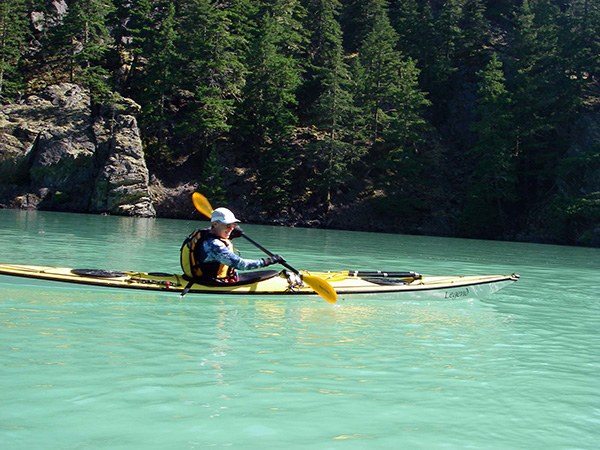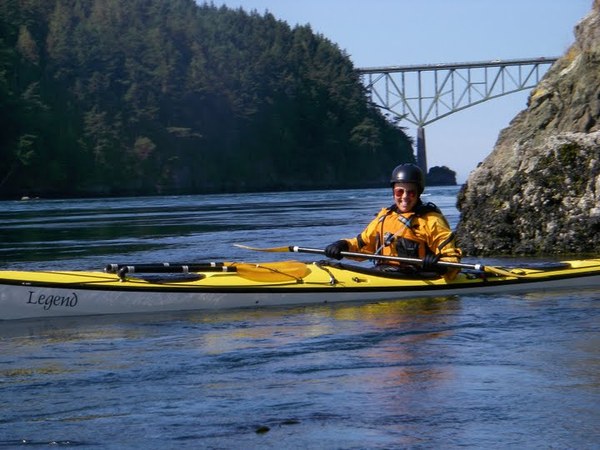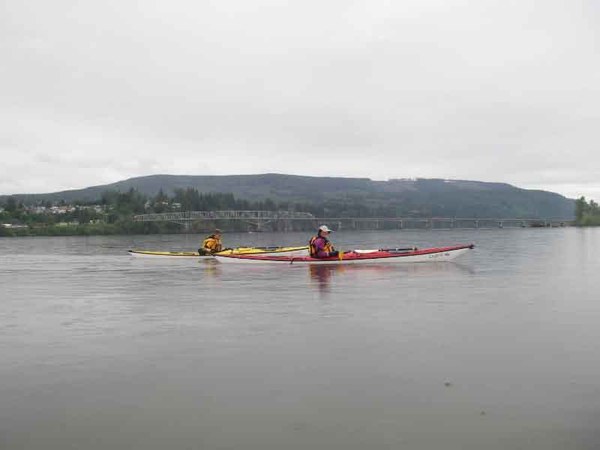
My partner Barbara and I were experienced campers and backpackers when we moved to Seattle in 2000, but we didn’t have much experience kayaking. We owned sea kayaks, had taken classes in San Francisco Bay, and we’d even done a kayak camping trip for a week in Prince William Sound, Alaska in the 80s. But we knew that Puget Sound was both fabulous and challenging for sea kayaking, and we’d better have more training before heading out there. As soon as we joined The Mountaineers, we signed up for the Basic Sea Kayaking course.
In our first class, two students were explaining what attracted them to sea kayaking. They were backpackers and had done an arduous hike to a beautiful and remote spot on the West Coast. They had set up camp and were heating water to rehydrate their freeze-dried dinner and make tea. While fixing up this humble dinner, a group of sea kayakers landed on their beach. The kayakers proceeded to pull steaks, a grill, and a Dutch oven to make dessert from their boat hatches. Bottles of wine emerged from the bows. In that moment, the two hikers decided sea kayak trips had some definite advantages over backpacking.
For ten years and more after our first course, Barbara and I volunteered as mentors, lecturers, trainers, and kayak trip leaders for The Mountaineers. We also began touring in our boats. Over the many trips we have done since then, I have planned, tested, and prepared a lot of camping food. Some meals were better than others; some were outstanding. I also developed a method for organizing the food and meal preparation, and I’ve taught seminars both for The Mountaineers and at a kayak symposium on food planning for extended trips.
 Enjoying a paddle at Deception Pass.
Enjoying a paddle at Deception Pass.
The importance of meal planning for sea kayaking trips
There are stories of folks on kayak trips who did not want to be bothered with meal planning, preparation, and clean-up, and who opted to just bring power bars or ramen noodles packages on extended trips. By the third day, they would be trying to trade their food for something, anything else. I confess, for one of the first car camping trips my partner and I did together, I made a similar mistake. I prepared a big pot of cooked brown rice with raisins and tamari-roasted nuts and seeds. Such good nutrition - high quality carbohydrates, protein, and vitamins and minerals. It didn’t go over well. By the third day, I would say the raisins were “plumped up;” Barbara said they were “bloated.” It was not a hit.
Food for kayak camping has to satisfy you but not tax you when you may be cold, wet, and exhausted from a long day of paddling. It’s important, especially on a long trip, to have enough good balance of carbohydrates, proteins, and fats. Sometimes someone would say, well, if there isn’t enough, I could stand to lose a few pounds. Big mistake! For safety and comfort, a paddling trip is not the time to skimp on calories. Paddlers without enough energy may “hit the wall” and not be able to keep up with the group, thereby endangering themselves or stressing out their fellow paddlers when favorable tides and currents are dependent on timing. On top of that, paddlers low on energy may be at risk for hypothermia, and without enough calories, they may be sleeping cold.
Days on the water can also be hot and strenuous. As you lose electrolytes in your sweat there has to be enough salt in the food to avoid feeling weak and faint. Food that doesn’t upset digestion is important, especially if you’ll be paddling through rough water and are prone to motion sickness. Eating the right carbs and enough fat avoids constipation. If you’ll be in bear country, it’s good to avoid cooking something that would smell enticing to a bear. In fact, some kayakers go vegetarian on trips for this reason.
On any group trip, the decision must be made in advance for how meals will be handled: Will each member of the group take turns preparing one or two meals for the whole group, or will each individual or couple cook for themselves? I’ve had the advantage on our trips that I only plan and cook for Barbara and myself, and I know how much we’ll need to eat and the kinds of meals we like. You don’t want to have leftovers, which could be a storage or disposal problem and might attract critters. The folks we do trips with also like to prepare their own meals because each person/couple has strong preferences.
Packing tips
Minimizing packaging is key to reducing time and hassle on the trip. For safety and packing reasons, no cans or glass containers are used. “Leave no trace” means all packaging must be burned or carried home. Burning plastic is not an environmentally sound practice, so the plastic comes home. The amount of paper and cardboard are minimized by pre-measuring into Ziploc bags before leaving home or taking plastic or foil pouches out of their boxes and saving only the descriptions and instructions. We come home with a lot of Ziploc bags that get reused on future trips.
Our cooking kit is compact. Minimizing the cook kit is important for minimizing clean-up and dealing with the limited storage space in a kayak. The stove is a backpacker’s burner that connects to a fuel canister. The stove, lighter, adjustment tools, instructions, and the pot grabber fit into a metal container with a telescoping lid, which serve as a large and a small cooking pot respectively. Then we each have utensils, a small bowl and plate, and a mug with a tight lid. That’s all we need, although we usually add a small plastic cutting board and a cleverly folding, small aluminum stove table.
We typically have two “bear-proof” canisters and one or two duffel bags of food, depending on the duration of the trip. All of the lunch stuff and breakfast stuff is packed together, separated into one-day, per person allotments. The ingredients for each dinner are in a heavy, clear plastic bag, with a note stuck on the inside but readable from outside, detailing the contents. Everything required to prepare that dinner, except the butter or oil, will be in that bag, along with a Ziploc bag of happy hour snacks and a Ziploc bag of dessert treats. Separate Ziploc bags hold the plastic “cream” jars of peanut butter, cream cheese, and butter, while 2-4 oz. Nalgene bottles hold oil and vinaigrette.
Keep breakfast and lunch simple
For us, breakfast is easy. On a short trip, we may have granola with yogurt and boxed orange juice. On a longer trip, Barbara loves a breakfast of Logan bread on which she spreads either peanut butter or cream cheese. Logan bread is dense, rich, and somewhat sweet; it’s more like a bar than bread. It was concocted by climbers who wanted a good, nutritious and easy meal when climbing Mt. Logan in the Yukon. It’s a breakfast that requires no preparation at camp and can be eaten while packing up gear and loading the boats. I need coffee as well, but we use the very best instant to avoid the hassle and mess of grounds.
Lunches are easy too. Sometimes on a day in camp we will have whole wheat flour tortillas, with peanut butter and a handful of trail mix, rolled up like burritos. If we’re out paddling, we will land for a break and lunch will be something ready to eat and easily accessible from the day hatch. Often this will be a power bar, string cheese, and some dried fruit and nuts. We’ll each keep a power bar or a fat Tootsie Roll in a pocket of our PFD (personal flotation device) in case a snack is needed on the water and we can’t land for a break. Tootsie Rolls are good because they’re fairly indestructible, have a long shelf life, and don’t make a mess if they melt. The trick is to remember to take snacks out of any pockets for the night if they aren’t eaten during the day, lest critters chew holes in your expensive and important PFD. Since we store our PFDs in the covered cockpits of our boats overnight, a bear or big raccoon could also damage a boat to get at forgotten snacks there.
What's for dinner?
When we land for the day, the first order of business is to find suitable tent sites. The second is to pull up the boats and begin unloading our gear. Then the tents and tarps are set up and the kitchen area is established. Setting up the kitchen means arranging a shelter with tarps for rain and wind protection, and establishing a sitting area for cooking and eating, away from the tents. It is possible, although it’s never happened to us, that conditions could be so miserable that it’s too difficult to cook. You don’t want to be fussing with food preparation if there’s driving rain with gale force winds. For this reason, most of the meals I prepare could be eaten cold. You wouldn’t want to, but you could. The possibility of really bad weather, bad enough to make it inadvisable to be out on the water for days, means that we always bring several more days of food than we expect to need.
As soon as practicable, we select which dinner we want that night and start eating the happy hour snacks from that bag while setting up our tent. Happy hour snacks are usually salted nuts and seeds or trail mix. On a really hard, cold and wet day, my first task may be to make hot chocolate as well, while Barbara continues to unload gear and set up our site. Dinners are rarely eaten late so dishes can be washed and food hung while it is still light out. All food, drink, dishes, toothpaste, sunscreen, soap, and food preparation items, except the “bear-proof” canisters, are hung from a high tree limb before dark, far away from the tents.
Dinners that I prepare have to meet our criteria and are often tested at home to ensure this. First, the preparation must take no more than ten minutes, and most of our meals take less. This is important not only to save time when you’re tired and hungry, but also to save stove fuel. This requirement rules out most commercial soup mixes, instant rice and most pasta. Many Asian noodles, like ramen, cook in just a few minutes, and there are pre-cooked pouches of rice and vegetables available in supermarkets.
Another consideration is water usage. All of our meals are designed to waste little or no water. On some saltwater trips, fresh water is in short supply. We usually carry large bladders of fresh water (we call them the “seal pups”), clipped into the floors of our cockpits.
As at home, I do the cooking, Barbara does the clean-up. She borrows my rubber boots and wades out from the shore with some biodegradable soap and the dirty dishes. She has found a particular algae that is good for scrubbing the pot. Or sand works too.
Our favorite dinner recipes
Last but not least, we pack food that we will want to eat and enjoy. Barbara has two favorites that she always requests. They both take a little more time and fussing, so I make them on nice days when I’m not too tired and have some extra time.
The first we call the Thanksgiving dinner. In the big cook pot, I rehydrate dried mushrooms and parsley. I then add freeze-dried peas, pre-cooked chicken (from a foil pouch), butter, bouillon, and instant stuffing mix with poultry seasoning to the large pot. When that’s finished cooking, I cover the pot to keep it hot. Then I fix a foil envelope of turkey gravy mix in the small cooking pot, which takes about two minutes. The food in the big pot is divided into bowls, the gravy is poured over, and dried cranberries are added as garnish. This is as complicated and time-consuming as the cooking ever gets.
Barbara’s second favorite is the spaghetti dinner. I cook together two packages of ramen noodles (without the flavor packets), dried mushrooms and parsley, concentrated tomato paste from a tube, sun-dried tomatoes, olive oil, a pre-mixed bag of Italian seasoning, dried onion, garlic, and peppers, and textured soy protein that has the texture and flavor of ground beef. This is served with parmesan and Romano cheese that I freshly grated at home and put in a Ziploc bag.
One of my favorite meals is a hearty split pea soup, made with good dehydrated pea soup flakes purchased in the bulk foods section of our grocery store, freeze-dried corn, pre-cooked real bacon bits, and olive oil. Another is chicken couscous, with pre-cooked chicken from a foil pouch, couscous mix, pine nuts or sliced almonds, shredded unsweetened coconut, curry, butter, and golden raisins. Each of these ingredients is packaged at home in its own Ziploc bag.
What about vegetables?
Obviously, on extended trips we lack a lot of fresh vegetables. Food spoilage is not an issue because sea water is usually 40-50˚F, which ensures that everything stored in the hatches remains cool. However, delicate vegetables won’t survive on a kayak trip given the packing and unpacking of boats as well as how tightly everything is fit into the hatches. It is possible to eat kelp and while very nutritious, it will give you diarrhea if you eat too much. One of our vegetarian friends showed us a better option. She put a wedge of cabbage and a carrot in a Ziploc bag. Separately she carried a small Nalgene bottle of vinaigrette. In camp, the cabbage is sliced thinly, and the carrot is cut into matchsticks. Mixed and served with a drizzle of dressing, the cabbage makes a wonderful salad that can last well into the second week of a trip.
Other options for sneaking more vegetables into your meals are Indian dinners. We’ll purchase two pre-cooked entrees in foil pouches in the grocery store and serve them over instant mashed potatoes or pre-cooked rice. These we test at home first so that we know which ones will complement each other (and not be too spicy for us). In our experience, Jodhpur lentils and Kashmiri spinach, or Madras lentils and Jaipur vegetables, are good combinations. These are compact, quick dinners that add vivid flavors to our meals. The foil food pouches are heated in the water that is then used to rehydrate the mashed potatoes in the bowls. Butter is stirred into the potatoes and the Indian food is poured over the top.
11th Essentials
What about dessert? Each dinner bag has, in addition to the happy hour snacks and the entrée ingredients, a snack bag with either Dove chocolates or two small candy bars, maybe Snickers or Heath bars.
And what about drinks? Some kayakers claim that the bow of the boat is designed to carry a bottle of wine. That may be true on a short trip, but it won’t be practical on a long expedition. If space allows, we buy a box of wine, take the plastic bladder out of the box, and put it in a ditty bag that we can hang from a tree. The bag will protect the plastic and we have cut a hole in it for the spigot. If it’s a longer trip or we need any spare room for fresh water, we settle for a “fifth” of something like Canadian whisky that comes in a plastic bottle (for example, Black Velvet).
 An overcast day on the water.
An overcast day on the water.
Be prepared for a “Bad Day”
And this brings me to describe my final innovation. Not every trip, but sometimes, there is a “Bad Day.” This may be due to bad weather, sea conditions, health, navigation or equipment problems, friction with others, or all of the above. On days like this, there is no energy or enthusiasm for cooking or clean-up. This is when we have our “Bad Day” dinner — a pouch of pre-cooked rice and vegetables and a pouch of pre-cooked chicken, which are heated in water and emptied directly into the bowls, so the pot doesn’t have to be cleaned. Each dinner includes extra chocolate and two mini bottles (i.e. a “nip” of scotch or bourbon). By the time you have a bad day, you may have run out of all other "adult beverages." It’s satisfying, easy to digest, and quick to fix and clean up.
As one of my friends always said, “If dinner is the best thing that’s going to happen to you all day, it better be good.” Happy meals, happy paddling.
Lead image of Karen's partner Barbara at Ross Lake. All photos courtesy of Karen Borell.
Add a comment
Log in to add comments.HI Ladies. I moved from the SF Bay area where I was in BASK to the Oregon coast. I just found the mountaineers and joined. Do you teach workshops on preparing food for expeditions? I'm tired of just mountain house and need more variety. Have you paddled the Broughtons? Or west coast of Vancouver island?I'm going this June to the Broughtons. THnaks for the article. Make sense.
Ken Sund
Thanks for all the useful, kayak-specific information. It wouldn't have occurred to me to take snacks out of my pfd pockets.
"The Mountaineers always have such informative posts! I tried their "Happy Meals for Happy Paddling" recipe during my last kayaking trip, and it was a hit with my paddling buddies. It's amazing how good food can elevate the overall experience. Thanks to the Mountaineers community for always sharing such helpful tips and resources!"
For More Info:-https://deepcovekayak.com/
 Karen Borell
Karen Borell